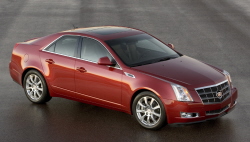An active discussion of the 2008 Cadillac CTS at GMInsideNews.com has brought to the fore one of my favorite topics: vehicle size. Detroit’s critics for years have charged that it has never grasped that not everyone feels that a bigger car is a better car. And they’ve had many grounds for doing so. For years Detroit refused to offer compact cars with the features, materials, and build quality of its larger cars. And yet there has clearly been a market for premium compacts. Looking about the current landscape, has Detroit learned this lesson yet? And how much should they take it to heart, once they do?
 The Cadillac CTS inspired this particular debate because it is positioned against the BMW 3-Series but is the size of a BMW 5-Series. From Detroit’s traditional perspective, this should be an advantage for the Cadillac. After all, even BMW must agree that bigger is better, or they would not charge roughly ten grand more for the larger car. But many potential buyers don’t want a car larger than the 3, because larger cars do not feel as agile as smaller ones. I personally have a harder time feeling directly connected to a larger car.
The Cadillac CTS inspired this particular debate because it is positioned against the BMW 3-Series but is the size of a BMW 5-Series. From Detroit’s traditional perspective, this should be an advantage for the Cadillac. After all, even BMW must agree that bigger is better, or they would not charge roughly ten grand more for the larger car. But many potential buyers don’t want a car larger than the 3, because larger cars do not feel as agile as smaller ones. I personally have a harder time feeling directly connected to a larger car.
But how many buyers feel this way? Even the 3-Series has continuously grown larger and heavier over the years. Twenty years ago, the 3-Series sedan had a 101.2-inch wheelbase, was 64.8 inches wide, and weighed about 2800 pounds. Today it has a 108.7-inch wheelbase (almost as long as that of a 1987 7-Series!), is 71.5 inches wide (a bit wider than a 1987 7-Series), and weighs about 3,300 pounds. The car’s length has only increased a couple of inches, but wheelbase, width, and curb weight have the most impact on driving feel. Especially width.
And you’ll find the same is true of nearly every model, regardless of manufacturer. Nissan recently reduced the size of the Altima a bit when redesigning it for 2007, but this is a rare exception. In general cars in all classes–sports cars, sedans, minivans, SUVs, pickups–have been getting larger and heavier. If the market doesn’t tend to think bigger is better, then why do all of these cars keep growing?
Time was, Detroit was criticized for offering bigger cars with bigger engines than the Japanese and Germans. Why did so many GM sedans have a “huge” 3.8-liter V6, when the Japanese were getting top-notch performance from a 3.0-liter? But these days you’ll find that the largest minivans come from Japanese brands, and that the typical Japanese family sedan is available with a 3.5-liter V6. Is a 3.8 that far off? Mitsubishi already offers one.
Even looking to the CTS’ segment, Infiniti has had a great deal of success offering the G35, which was a half-size larger than the BMW 3-Series when introduced, while Lexus has had mixed results with the rear-legroom-challenged IS. The secret with the G35 from a driving enthusiast’s perspective: it was about ten inches longer than the 3, but only half an inch wider.
So, while I personally prefer smaller cars, and lament the continuous increases in size and weight, I cannot blame Detroit for being confused. They were told to produce cars and engines sized more like those from Japan and Germany, but over the last couple of decades the Japanese and Germans have continuously moved in the direction of Detroit.